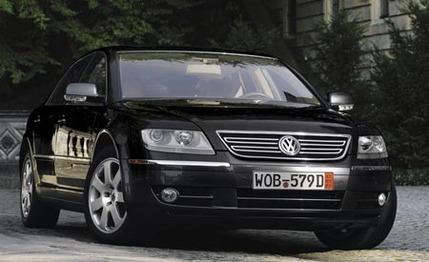
 First Drive Review
First Drive Review
The days when Volkswagen translated to "people's car" are over. This car, the Phaeton, stretches to 199.0 inches in length, is powered by a 12-cylinder engine making 414 horsepower, and features an air-conditioning system so complex it splits the interior into four separate zones. When this humble VW goes on sale in the U.S. next year, top-of-the-line versions will cost $85,000. Maybe more. Yet just like a $15,600 Golf, the Phaeton wears Volkswagen badges.
VW's new luxury sedan takes on the Mercedes-Benz S-class, the BMW 7-series, and the new Audi A8 and Bentley GT Coupe, in-house rivals that share many of the same mechanical components. Masterminded by Ferdinand Piëch, VW's recently retired chairman, the Phaeton set out to be nothing less than the best car in the world.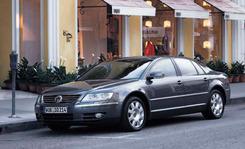

The key is turned in the dashboard-mounted ignition. Nothing. Only after sighting the tachometer needle trembling at 640 rpm do I realize the engine is alive. With the windows up, it's so quiet you can't hear the W-12--effectively two narrow-angle V-6s bolted onto a common crankshaft at an angle of 72 degrees.
Give it some gas, and the engine emits a distant burble. At 80 mph it remains mute, unheard over the hum from the 255/45R-18 Bridgestone Potenzas. At 100 mph, wind noise from the exterior mirrors begins to intrude. You only hear the engine as a remote purr when you step up the pace.
Opening the aluminum hood--the grille rising with it--explains how VW has achieved this level of refinement. The W-12's striking magnesium intake manifold virtually fills the small open space in the crowded engine compartment. A one-piece rubber seal surrounds the engine opening to mate up with another on the hood, which wears a lining of dense soundproofing.
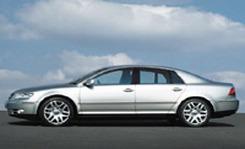

VW's 6.0-liter W-12, introduced on the Audi A8 in Europe in 2001, produces the same 414 horses and 406 pound-feet of torque, with one important difference: The Audi uses dry-sump lubrication; VW prefers wet-sump. Like the A8, the W-12 Phaeton drives all four wheels via a ZF five-speed automatic transmission.
The entry-level Phaeton, expected to cost $55,000, will be powered by a 3.2-liter V-6 for Europe. But for the U.S., the base model will retain four-wheel drive and come with a version of Audi's 4.2-liter V-8 (rather than the Passat's 4.0-liter W-8 that's not considered sufficiently powerful to bridge the gap between the V-6 and the W-12) and, in Europe, V-6 and V-10 turbo-diesels.
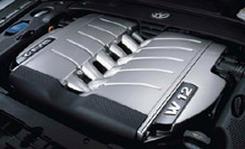

Smoothness comes naturally, the balanced weighting of the major controls contributing to the sense that this is a beautifully coordinated car of intrinsic quality. The electronic accelerator is long of travel to make pulling away as smooth as possible. The steering is quick (2.7 turns), and the Servotronic assistance is light at suburban speeds to isolate the driver almost totally from the action, although the weighting increases as the speed rises. Push harder, and the W-12 effortlessly gathers momentum. It's quicker than it feels--0 to 60 mph takes about six seconds --because it's so quiet and you don't feel the automatic upshifts; you only see a fall in the tach needle and hear a decline in the muffled exhaust note. Yet the perception that this is a very heavy car never goes away. All the toys--the all-wheel drive, the numerous measures to achieve nearly silent running, and the largely steel construction (the A8 being of aluminum)--mean an immense weight of 5100 pounds, heavier than all its rivals (an S600 Mercedes is 600 pounds lighter).
Not surprisingly, the W-12 Phaeton is more of a hedonistic wafting device than a sporting limousine. It's closer in feel to a Mercedes S-class or Lexus than a 7-series or A8.
Most drivers will leave the automatic in drive or Sport, yet the Phaeton delivers two other methods of changing gears. Tap the console selector to the right, and you enter Tiptronic-land. As an option, there are Ferrarilike cast aluminum paddles affixed to the steering column. They perform the same Tiptronic function, only more naturally.
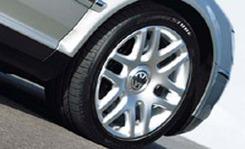

Not that you can hold the transmission in gear. Once the engine reaches 6300 rpm, it slips up a ratio. Top speed? The Phaeton plays along with the self-imposed German limit of 155 mph (although Porsche doesn't), but the engineers concede dealers can remove the electronic limiter, lifting max speed to 178 mph.
With the help of Audi, the VW engineers developed a clever height-adjustable air suspension that sets out to achieve the contradictory aims of comfort and sportiness. Each wheel of the four-link front and control-arm rear suspension gets a pneumatic strut and air compressor for its springing, the system using four level sensors and three body-acceleration sensors to adjust spring and damper rates in milliseconds. In most circumstances, the ride is super-cosseting, the combination of soft springing and great mass working together to smooth out irregular road surfaces. Even in the default Base setting, level two of four selectable positions from Comfort to Sport 2, the suspension feels remote, separating the occupants from the road. In Comfort, the ride is squishy and chassis responses slow, despite the suspension switching to a firmer setting in 0.5 second to control body movements.
On the concrete autobahn, the difference between Base and Sport 2 is obvious over the frequent expansion joints. In the hard setting, the suspension is taut, jerking harshly over bumps and occasionally crashing through to the body, despite torsional rigidity that sets a production-car record of 27,300 pound-feet per degree. Predictably, the basic handling attitude is contained understeer. To halt the mass, VW employs eight-piston Brembo brakes with fixed-yoke technology previously seen on the Lamborghini Murciélago. Modulation is progressive, but the brakes moan in a powerful high-speed stop.
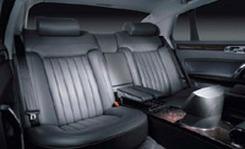

The cabin is a comfortable, superbly finished place, although it lacks the S-class's spaciousness. Six-footers can ride in tandem, the back seats matching the large front buckets in comfort, although the vast central console, effectively dividing the cabin into four separate zones, restricts lounging room. The Phaeton is laden with every conceivable goody and some you've never thought of, such as vanity mirrors offering two degrees of magnification or the ability to read the entire owner's manual on the car's console screen. The result is 120 buttons and switches, without counting the 14 on the steering wheel, or the 48 for the rear passengers, who each enjoy individual A/C settings. And somehow the "infotainment" system is more intuitive than that in the 7-series.
Sumptuous and silent, swift and serene, the Phaeton immediately establishes its credibility. Is that going to be enough to tempt luxury-car buyers away from their Mercedes S-classes and BMW 7-series.